Interesting Stuff
More notes from my conversation with Antonio Cerveira Pinto, the curator of Bios 4. It's probably the first time that so many unstable art works are being shown for several months in a museum (as opposed to a few days in an art gallery during a festival) and, as Antonio notes, the experience has shown that there's a whole new relationship to be built between on the one hand, artists who use technology in their practice and on the other hand, museums which are usually wary of showing works that are not static and "quiet" like paintings are.
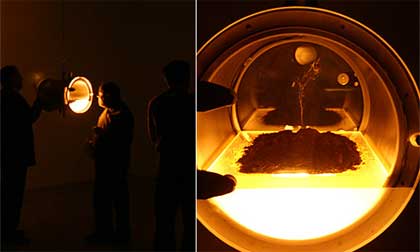
The existence of bio art, environmental art and in general new media art constitutes a challenge for museums. They have to be aware that art is evolving, and open up to new artistic forms. New expertise is needed to deal with machines and living things. Robots need to "rest", for example. Otherwise their electro-circuit dies. Museum curators and directors also have to accept that if you want to hide a computer in a sleek box just because it is "ugly", the container should be big enough to avoid any crash when the machine heats up.
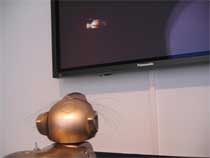
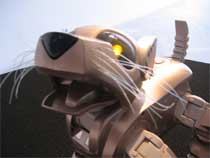
When preparing an exhibition, Antonio Cerveira Pinto likes to set up a small workshop with the museum employees, to explain them what the works are about, how the public should interact with them, what they must be cautious of, etc. I often noticed that exhibition attendants (how do you call them? guards?) seem to be quite happy when they have to keep an eye on interactive pieces. They are proud of showing you how to play with the art work, which buttons should be pushed and how, propose to take a picture of you when you play with a screen-based work, smile when they see how much kids or adults engage with the work, etc. Suddenly they have something to do, they have a knowledge to share.
Artists on the other hand, have to specify clearly how the museum has to manage and take care of the electronic, digital or living bits of their work when they are exhibited over a long period of time (as these pieces are usually shown in the context of a one-week festival). Another challenge for artists is to become experts in usability and design clear interfaces that tell visitors how to interact with their pieces.
The public too has to learn how to engage with these art pieces, adults in particular have spent decades being told "Don't touch!" "Don't go too close!", etc. Both museums and artists will have to take these challenges into account.
First image is from C-Lab's project The Martian Rose. See also their interview and the report they wrote of Bios 4.
Second set of images is from the installation Do robotic cats dream of electric fish? by France Cadet.
Thought that nothing can beat the Hulger? The Strijk-O-Foon (which i'd roughly translate as Iron-O-Phone) works only for Siemens mobile phones though. Plug the iron, wait for a call (or ring a friend) and get the Strijk-O-Foon experience in its full hot glory.
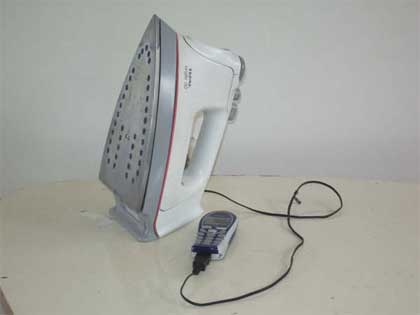
A work by Jelle de Bruijn.
Via Squeaky from.
- Interactive paper sounds exciting
Boring billboards can be turned into interactive displays by using conductive inks to print touch sensors and speakers onto paper. The return of interactive wallpapers!! - Breakthrough brings 'Star Trek' teleport a step closer
A team of physicists has teleported data over a distance of 89 miles from the Canary Island of La Palma to the neighbouring island of Tenerife, which is 10 times further than the previous attempt at teleportation through free space.
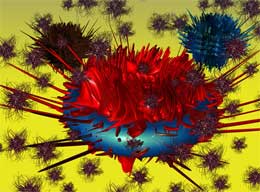 The first Biosphere is Gaia, the planet Earth.
The first Biosphere is Gaia, the planet Earth.
Biosphere 2 was an artificial closed ecological system constructed in 1987/89 in Arizona. It was used to test how people could live and work in a closed biosphere, while carrying out scientific experiments. It explored the possible use of closed biospheres in space colonization, and also allowed the study and manipulation of a biosphere without harming Earth's.
BIOS-3 was a closed ecosystem at the Institute of Biophysics built between 1965 and 1972 in Siberia. It consisted of a 315-cubic-metre habitat suitable for up to three persons.
BIOS is also a computer term that stands for Basic Input/Output System.
Bios 4 is the exhibition on bio and environmental art currently running in Sevilla and if you trust dear old aunt Régine, you should book a flight to Sevilla and visit the show because you're not going to see anything like that anytime soon.
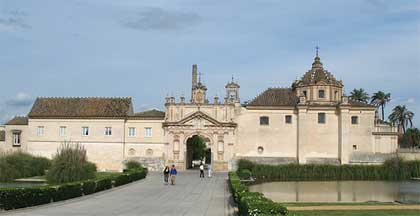
The Centro Andaluz de Arte Contemporáneo (image by Amy Youngs)
Here's the blurb about the exhibition:
The launch of the Human Genome Project in 1990 -the identification of the 20.000-25.000 genes of human ADN- would have been difficult to realize in only 13 years without the power and speed of digital computers. That's also the moment when environmental and biological art started to emerge. Bios 4 is an exhibition and an information platform that showcases a selection of examples of these two important categories of art on the 21st century.
The close collaboration between artists, scientists and technology experts to develop new creative projects characterizes this recent area of investigation that brings the art closer to knowledge. That's what the curator of the exhibition, Antonio Cerveira Pinto, calls "cognitive art." Cognitive Art emerges when artists have to build up specific scientific or technological set of skills and knowledge in order to use them in their own artistic process. The use of this new knowledge and cognition symbolises a "post-contemporary" culture. The artists' work is not always perfect in terms of form, what matters is the questions that arise from it.
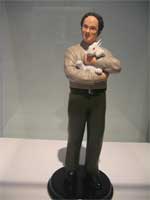
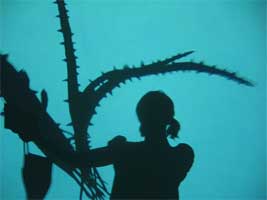
A statuette of Eduardo Kac with Alba (!!) and Mark Cypher's spectacular Biophilia
The raw material of artistic expression of biotechnological art or bioart, which has some roots in the Body Art of the 1960-70, is life itself or its components (genes, organs, organisms, tissues), or the virtual living matter, digital stimulation of ADN, of proteins, and of course it can also be the result of the intersection of those twohose two realities. A philosophical and ethical debate has recently sparkled from the interest for the new potential for manipulating the living. Bioart takes part into the discussion with works that often reflect an ironic metaphorical exercise or a clearly critical one.
For the art of nature/ecologiy/environment or of sustainability, which antecedents can be traced to the Land Art of the '70s, the medium of artistic creation is the natural sphere in all its extensions and complexities. The idea of the close connectivity between all the organisms that represent terrestrial life for billions of years inspire the dynamic definition of this new artistic field. Issues of pollution, the exhaustion of fossil fuels of energy sources and global warming are turning into the main areas of concern of the environmental artists of this new century.
Antonio Cerveira Pinto points out that the art arising from post-contemporary complexity does not focus on the forms spawned by technology but focuses on the worlds that are possible for a humanity surrounded by technology while threatened by energy exhaustion and ecological imbalances. The works selected in Bios 4 bear witness to a way of making art that embodies both scientific curiosity and the poetical formulation of a new type of knowledge.
Image on top left corner is Machinic Diatoms by Ken Rinaldo. The 3D irrealities envision the day when designer molecular constructors will permit unicellular machines, nano machines to co-inhabit (invited or not) and maintain the body.
Bios 4 - Technological and Environmental Art runs until September 2 at the Centro Andaluz de Arte Contemporaneo, Sevilla.
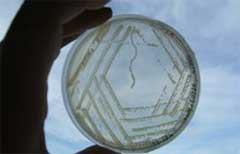 Another work seen at the Bios 4 exhibition:
Another work seen at the Bios 4 exhibition:
Decon, Marta de Menezes's latest project is a series of "living" artworks inspired by Piet Mondrianâs geometric paintings.
The colors from those paintings are progressively degraded by the bacteria Pseudomonas putida MET94, a "microorganism of putrefaction." With an appetite for organic pollutants, this soil microbe has the potential to be used for bioremediation, a process that uses microorganisms, fungi, green plants or their enzymes to return the environment altered by contaminants to its original condition. The artist collaborated with LÃgia Martins whose research lab investigates the use of inoffensive bacterias to "clean" up textiles which are coloured with nocive chemicals. Cleaning and de-toxing them means that the textiles can then be recycled.
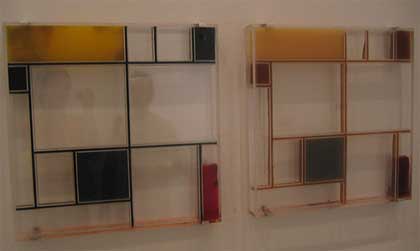
The "paintings" only exist while they are being degraded by the bacterias which are living, and dying in the gallery space. Thus, one can interpret those paintings as a process of death and decomposition of the artwork. The strange thing was to see how some colours were fading faster than other. While the blue, for example seems to be literally eaten up, the yellow was covered with dark stains.
- CB2 baby humanoid robot ::: Pink Tentacle
Osaka Universityâs Graduate School of Engineering unveiled a robot that acts like a human infant, which they hope may one day help scientists better understand the child development process. - Putting people first » Bruce Sterling moving to Torino, Italy
OMG! Turin does not deserve you Bruce. - Dave and Esty » Grill-on-the-run
A fully portable hand held grill requiring nothing more than a flame and your favourite cut of meat. - NewGenics: If You Build It (out of DNA), They Will Come (with money)
What is constructive biology? it's a trademarked neologism that a start up named Codon Devices is using to position themselves as the avant garde in biotech.
Yesterday i spent a few fantastic hours with Antonio Cerveira Pinto in Sevilla. He showed me around Bios4, the exhibition about bio and environmental art he curated at the Centro Andaluz de Arte Contemporaneo. I am going to write about it from A to Z, focussing on some of my favourite pieces and bits of my conversation with Antonio. But let's start the lazy way with just an appetizer of what i've discovered there.
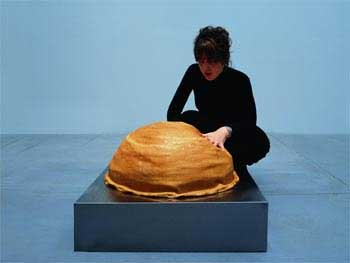
Alexithymia is a term that means the incapacity to verbalize emotions. When some sufferers want to talk but are unable to utter the words, they start sweating to manifest the desire to communicate.
Alexitimia is also the name that Paula Gaetano, an artist from Buenos Aires, gave to her robot. It's a big blob that feels like rubber when you touch it. But it also sweats when you caress its surface. Paula Gaetano has a background in fine art but collaborated with scientists and techno experts to develop the robot. The only sensors are for touch and the only output is water that runs from a tank hidden in the base of the work.
It is creative intuition that permits both the artist and the viewer to leap over logic, whether scientific or artistic, and emotionally experience the problem laid out here of reconciling the "wet" domain of nature with the "dry" domain of electronics.
Winner of Vida 9.0.
Image mas de arte. The robot is not physically in the exhibition but only documented. Flickr set from the exhibition.
- Punk Planning: Regine Debatty - We Make Money Not Art
waw! these are very nice things to say. thanks charles! - Tezuka: Marvel of Manga
blog
- Public.TV - videos of talks and debates at Tate
- Russia: bambole in bottiglia, la protesta shock di Greenpeace
Nella giornata internazionale dedicata all'infanzia, decine di questi barattoli davanti al Ministero della Salute russo per protestare contro gli eseprimenti genetici e radiologici sui bambini.
A documentary that Shawn Bailey and Jennifer Willet from Bioteknica did a couple of months ago with Vision 360 has popped up on YouTube.
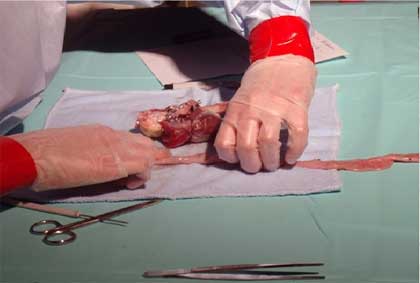
They talk about "live" tissue engineering, meat sculpture, bioart, and the need to raise public awareness on biotechnology and its impact on society.
Check also these Bio-Blurb radio interviews of people whose work intersects art and science, and particularly biological and genetic sciences.
Thanks Jennifer!
- Beyond Second Life
Companies thinking twice about the popular virtual world are finding more security and flexibility in alternatives (via foe) - Museum Show Spotlights Artghts Artistry of Manga God Osamu Tezuka
The Asian Art Museum in SF is jumping into modern culture with an interactive exhibit of the works of Osamu Tezuka, routinely referred to as "the god of manga." - Networked Music Review — Serial Port: A Brief History of Laptop Music by Marc Weidenbaum
Computer music is nothing new. The question is: Whatâs âlaptop musicâ? How does the fact that the technology now is portable alter computer-enabled music?
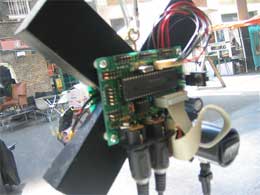 Yesterday afternoon i went to the Kinetica museum in London. It's a big glass box space located right in the middle of the Old Spitalfields Market, a place where people buy fake vintage t-shirts while munching on their organic sandwiches.
Yesterday afternoon i went to the Kinetica museum in London. It's a big glass box space located right in the middle of the Old Spitalfields Market, a place where people buy fake vintage t-shirts while munching on their organic sandwiches.
Soundwaves, the museum's current exhibition focuses on artworks that explore, warp, collect and manipulate sound and it is really good.
Favourite piece is Julie Freeman's Specious Dialogue. It took me a while to notice the existence of these unassuming cubes on wheels. They are made in concrete and can be pushed, rolled, kicked (didn't try) and shoved around the gallery.
The white cube is the "listener". If the sound around it suddenly gets louder â" if someone knocks it, whistles, speaks, or shouts at it â" it will start recording and store the sound (active mode). Sometimes the recorded sound will be passed to the black form for playback after a few seconds, sometimes it will be stored for future use, inserting it into someone elseâs dialogue.
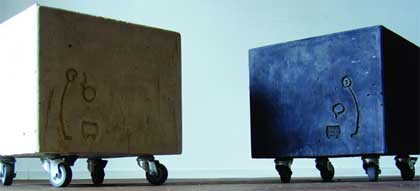
The grey form is the "speaker". It constantly outputs its chatter. Which sounds is it speaking is determined by two factors â" the distance between it and its white friend and whether or not the system is in active mode.
In active mode, the microphone in the listener allows contributions to be fed into the work, and the pre-recorded dialogue changes from personal to public. Pre-recorded sound clip harvested from all over the world are interwoven with recordings from the gallery and played back. Volume, distortion and tempo is altered capriciously, often changing the live and existing recordings into mumbles.
When the work it is the distance between the cubes that dictates which conversational fragments are played. Up close, they laugh, but also voice their contempt. When far apart they miss each other, but also they are angry and need their space.
Other works i liked:
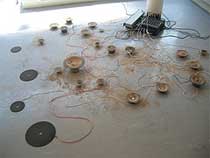
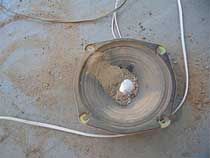
Lu Clarke & Jaye Ho have scattered 22 speakers near one of the entrances of the museum. The speaker diaphragms contain dust and dirt. When you enter the space, the sound of your footsteps captured by the contact microphones hidden under the floor and processed by a reverb effect-unit to repeat and echo. The sound is made visible throught the diaphragm that vibrates and agitates the dirt.
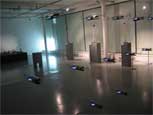
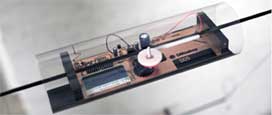
Martin Hesselmeier and Karin Lingnau's SARoskop is made of 25 objects hanging from wires from the ceiling and reacting to their electromagnetic environment, transforming the data into movement and oscillations.
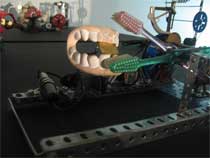
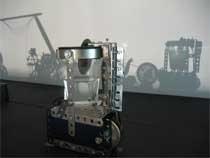
Upstairs a lovely orchestra of teapots, toothbrushes and other household objects by Pierre Bastien is playing with its shadow.
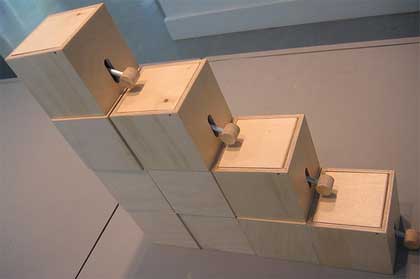
Andy Huntington's marvellously simple tapTap wooden boxes. Each box has its own memory and is self-contained. Tap on a box and a few seconds after the box taps back your knock. Tap on several boxes and they will all repeat your composition. The more boxes you use, the more complex the rhythm lines. By tapping for longer than the delay period, you play a duet with tapTap as it repeats your earlier rhythm.
Image on the top left corner is from Michael Markert's installation kill 2.1.
My images.
Soundwaves, a collaboration with Cybersonica, runs until 29 June, at the Kinetica Museum in London.
"The virtual communities created by online games have provided us with a new medium for social interaction and communication. Avatar Machine is a system which replicates the aesthetics and visuals of third person gaming, allowing the user to view themselves as a virtual character in real space via a head mounted interface. The system potentially allows for a diminished sense of social responsibility, and could lead the user to demonstrate behaviours normally reserved for the gaming environment."
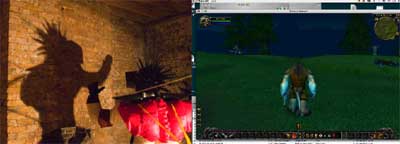
That was the blurb i read on the website of Charming Disaster , an exhibition featuring several works created by students of the Royal College of Artâs Design Products department (thanks Noam for telling me about it!) What i like about Avatar Machine is that, like the One Eye Ball but unlike several similar projects i've blogged in the past, it's not just about coming up with a nice, funky, geeky project before everybody else, it is also a very eye-pleasing work. I love the way that the designer pushed the concept further by making the user wear the costume of an avatar, i imagine that it allows observers to participate (albeit in a much more discreet way) to the experience. So i asked design student Marc Owens to tell me more about the work.
How does it work technically?
The system works in a very simple way. The user wears a body harness, which has three 2m long aluminium rods protruding from it, to form a type of tripod. A wide angle pinhole camera exists at the point where all three rods meet. The camera is pointing directly back at the user. The video footage being recorded by the camera is transmited to the monitor inside the headset so it can be viewed by the user. Therefore the user can see themselves in the third person, from head to toe on the monitor interface.
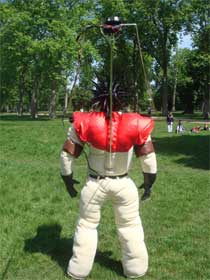
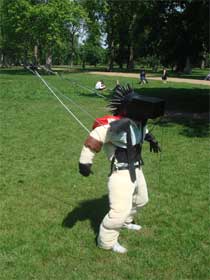
It is WoW that inspired the kind of costume that the player has to wear in your installation, did i get that right? Any reason why you chose to refer to WoW?
You are correct in thinking that the project is World of Warcraft inspired. As the worlds most popular online game, the asthetics and characters of WOW are the most easily recognisable, also i wanted the character i created through the costume be be large in stature, so the user could experience a sense in invincibility when controlling the avatar on the interface. Also, WOW, is more classically fantasy based than other MMORPGs, like second life for example, so that is an element i wanted to bring into the experience of the product.
Thirdly, i am ashamed to admit, quite a fan of World of Warcraft!
Which kind of behaviour did you observe when visitors of the Charming Disaster were playing with your work?
At the Charming Disaster show a few weeks ago, the screen within the headset burned out after an hour into the performance. So only one or two people had the opportunity to experience the system. However since then, i have carried out some avatar sessions in Hyde Park, allowing ample room for the user to do as they wish, and behave as they like.
The types of behaviour i observed were all quite similar. That being, everyone was quite cautious with their movements to begin with, moving around with baby steps as they slowly got used to controling their movement from the third person perspective. After a few minutes, users began to gain confidence not only with faster and more fluid movement, but also began to mimic the types on movement that they imagined the avatar would demonstrate, ie: stoping around and swinging of arms. Another element to the type of behaviour i observed was that after getting used to using the system, users felt comfortable enough to approach passing 'humans' and observed their reaction through the interface.
All images courtesy of Marc Owens.
- Regenerative 1.0 aims to generate a loop around body activity.
Design project focused on the generation of electricity from human body motion, redistributed as electronical nerves stimulation in order to enhance body motion through a virtuous circle. - Espacio Movistar, The Trend Sessions del Espacio movistar dedica su segunda jornada al Net Art
miss rhizome in barcelona
Andrew Doro and Pravin Sathe are working on a series of everyday items that deal with the life embedded within the objects, we buy, use and ultimately discard.
In the second series, Detritus (III - XIV), the artists focused on travel anxiety and created airline sickness bags that breathe when closed but start hyperventilating as soon as they are opened.

How does Detritus work? "There is a photocell that measures light, it just acts like a switch," explains Pravin Sathe. "When the bag is closed the photocell gets no light. We have it programmed so when there is no light it breathes slowly. When the bag is opened and the photocell receives light, the program tells it to breathe fast. The "breathing" is caused by a servo motor with two strings on either end attached to the side of the bags."
The objects comment on "ubiquitous computing", which promises to animate household items. In this case, items which do not appear to be computerized, particularly not for any practical purpose.
There's also the fear that ubiquitous computing can be harnessed to develop Improvised Explosive Devices and lead to technological paranoia. The artists hope to append their own ideas to ubiquitous computing reaching outside its helpful or nefarious aims into something more amorphous and ask the question: "Do inanimate objects have a life?" (more)
The next series the duo is working on are umbrellas that "breathe" as more carbon dixodie is added to the room (ie, more people in the room, the more an umbrella opens, the less people the less it opens).
- most ridiculous poodle
The Japanese-born French poodle named Smash defeated competitors from around the globe to be crowned Best in Show at the annual World Dog Show competition in Mexico.
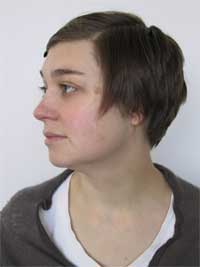 A few weeks ago, i went to Newcastle for the opening of the Picture House exhibition. It was at least minus 37 degrees up there and i was walking from one room of Belsay Hall to the other, watching the installations and following a girl with a nice bag that sported a funny phrase in crooked french. I still don't know if it was the bag or the girl i was stalking but i ended up having dinner with her under a (non-heated) tent. Anyway the girl with the funky bag was in fact Sarah Cook , researcher, co-founder and co-editor of CRUMB (the Curatorial Resource for Upstart Media Bliss), an online resource for curators, producers, commisioners and exhibitors of new media art. Sarah is also a post-doctoral research fellow at the University of Sunderland (England) and an independent new media curator. She has organized exhibitions, commissioned new media art and managed educational projects for BALTIC, Gateshead; Bellevue Art Museum, Seattle; Walker Art Center, Minneapolis; Banff New Media Institute; Reg Vardy Gallery, Sunderland; Locus+, Newcastle; etc. Oh! and she did an interview of me, should be online soon here.
A few weeks ago, i went to Newcastle for the opening of the Picture House exhibition. It was at least minus 37 degrees up there and i was walking from one room of Belsay Hall to the other, watching the installations and following a girl with a nice bag that sported a funny phrase in crooked french. I still don't know if it was the bag or the girl i was stalking but i ended up having dinner with her under a (non-heated) tent. Anyway the girl with the funky bag was in fact Sarah Cook , researcher, co-founder and co-editor of CRUMB (the Curatorial Resource for Upstart Media Bliss), an online resource for curators, producers, commisioners and exhibitors of new media art. Sarah is also a post-doctoral research fellow at the University of Sunderland (England) and an independent new media curator. She has organized exhibitions, commissioned new media art and managed educational projects for BALTIC, Gateshead; Bellevue Art Museum, Seattle; Walker Art Center, Minneapolis; Banff New Media Institute; Reg Vardy Gallery, Sunderland; Locus+, Newcastle; etc. Oh! and she did an interview of me, should be online soon here.
You co-edited the book Curating New Media in 2002. Has the panorama evolved a lot since you wrote that book? Are new media curators still facing the same challenges?
That book was the result of a three-day conference CRUMB organised in Newcastle/Gateshead in May 2001 and in retrospect might be considered the first such meeting of curators and producers of new media in the UK (it resulted in at least one marriage and baby!). At that time we were talking a lot about net-based art and how museums such as the Tate were commissioning artists to make work for their websites (in part because there was a dearth of venues for media art in the UK). We had curators with backgrounds in film and video (who were defining themselves as moving image or lens-based art curators), debating with commissioners from the Science Museum who were interested in interactive installations, debating with sound artists and net-artists who were just trying to get their work commissioned fairly. So while there were disciplinary boundaries to overcome, there were fundamental concerns which affected everyone up for discussion: funding, audiences, institutional support, and professional development.
Curators are still facing a lot of the same challenges today â" what is this new art, who is making it, where do I find it, how do I install, collect or preserve it? â" but their self-definition is helped by the fact that the landscape of art exhibition has changed and become more multifaceted. For new media art it's not just a question of whether to show it 'on the web or not' anymore (Though getting the Tate to realise that is still a challenge as I understand from the curators there). Art is now exhibited in spaces and places other than white cube galleries â" from science museums to media museums to festivals and even airports. The web has changed enormously too, so what we might have thought of as net-art then we might think of as research or social networking today. Curators understand that some work uses the web but doesnât result in a project that is solely exhibited on the web (it might have a physical component to it too). Artists, as usual, are using whatever medium necessary to realise their work and curators should be responding to that, no matter what their backgrounds may be.
How optimistic are you about the near future of new media curating? Do you see things of positive (and fast) changes?

CRUMB has organised a few workshops for new media curators which have taken the form of 'crisis centres' playfully suggesting that there are deep tensions at the heart of new media curatorial practice, most of which can be partially relieved by a good chat over a nice cup of tea. [For the Enter Festival in Cambridge in April we ran a âBliss Out Centreâ with Indian Head Massage, Open Source Embroidery â" courtesy of Ele Carpenter â" knitting, fortune teller games and other activities.] These tensions usually are from uncertainty about definitions of the art but also of the curatorial practice. What is the role or value of a curator in the age of 'user-generated content', to be only a filter or editor? How do the other seemingly invisible skills curators have â" about dealing with the press, being the interface between the art and the audience â" get supported? How do you learn the necessary skills to engage in the production of publicly sited art? I think curatorship, as a field of practice, is quite slow to evolve (certainly slower than the art is changing), and mostly because it is only in the last 15 years that curatorial practice has become reflexive (and some argue, overly so). But this is predominantly in the field of independent or freelance curating, which I am optimistic about. For instance in the way curators might evolve their social networking skills based on how we live and work on the web today, and therefore make their curatorial process more open, more collaborative (though does that result in better shows? Not always). 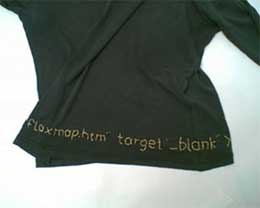
I suppose I am less optimistic about institutional curatorial practice as far as new media art is concerned, but only because art museums are themselves in a state of crisis and are dealing with it by moving away from having curators with any form of subject specialties at all (resulting in the cancellation of experimental programs or the closing down of departments - look at MoMA with its Media Department which is focused on video installation). If new forms of art aren't getting collected and well documented and written about or shown, then the depth of knowledge of the mainstream art curators who have to be generalists and have knowledge about everything is going to be limited (to what is written about in magazines, and to what they see when they go to the big art fairs). This means they might not be able to respond easily to the exciting projects that challenge the structures of the art museum or challenge the idea of what art is. Sorry, this is becoming a big long chew of a mouthful of an answer.
What do you think are the elements that hamper the integration of new media art pieces in museums?
In art museums I think a lot of the resistance to new media art has to do with the traditional ways of judging and valuing art â" new media art isn't always an object (it's a process or event), it isn't always unique (it's easily reproduced or made collaboratively, sometimes, god forbid, by the audience participating!), it therefore isn't always collectable (it can be ephemeral data or code) or even predictable as to what it will be. And it plnd it plugs in, so could break down, and that scares curators who are trained to put on exhibitions of unchanging, static objects.
I get bummed out having to write answers like that one above because while I know a lot of that is to a certain degree true, I also think good curators will be able to look to art history and say, but wait, conceptual art is ephemeral, live performance art is a time-based, interactive process which can't be collected, and still we have long histories of supporting that! Good curators look for the balance between form and content, and don't get hung up on the form or, in the case of new media art, the technology. That said, you do have to know something about the form â" enough to know why it might be significant for this particular work of art, or at least to know what you don't know!
I have had directors of museums tell me that they don't believe there is an audience for new media art, certainly not enough of an audience to warrant what they perceive to be an overly costly investment in it ("It costs £7.00 per head to put on a live media art event here and I'd rather give them £10.00 each and tell them to stay away!" one director had the gall to say to me). And I've had other art gallery directors say to me, "We don't show new media art because I haven't seen anything that I think is very good" when they are sitting next to the artists whose show they've just opened whose CVs include winning prizes at the Venice Biennial and only working with digital video or immersive and responsive sound environments. Hello?! Neither would admit they haven't seen very much new media art, or don't know where to look, or even what it looks like.
 So that's art museums, but your question didn't specify. In Science museums and Media museums it seems to me as though the integration is less hampered, perhaps because the curators there are less afraid of the form. Some of the only permanently installed, commissioned new media works on view in London are in the Science Museum â" perhaps because part of their remit is to engage in technological culture. The new British Film Institute Southbank venue has a gallery which is capable of showing all forms of interactive, immersive, responsive, data-driven new media art; though whether theyâll show anything more than film and video installation remains to be seen.
So that's art museums, but your question didn't specify. In Science museums and Media museums it seems to me as though the integration is less hampered, perhaps because the curators there are less afraid of the form. Some of the only permanently installed, commissioned new media works on view in London are in the Science Museum â" perhaps because part of their remit is to engage in technological culture. The new British Film Institute Southbank venue has a gallery which is capable of showing all forms of interactive, immersive, responsive, data-driven new media art; though whether theyâll show anything more than film and video installation remains to be seen.
Your webpage says that you are a curator of contemporary art. Your practice is mainly concerned with new media art. Do you regard new media art as a distinct entity or would you rather see it as "just" another form of art?
I've worked in museums and galleries of contemporary art and feel comfortable in each world. My background is in philosophy, modern history, contemporary studies, not art history. I think it's funny two of my degrees have the word contemporary on them, written in Latin, loosely translated as Aetatem recentissiman pertinentibuss as there is no actual word for "contemporary studies" in Latin â" there is only 'pertinent to the recent time' studies. So for me new media art is the most 'pertinent to the recent time' art. New media art IS art (not JUST art) and as an ever-changing field of practice it has the potential to completely redefine what art is, just as it might redefine what new is, or what media is.
What are the conditions required to achieve "upstart media bliss"?
Tea and cookies and wifi? As a curator, keeping up with the times but not âdancing the novelty hustleâ (as Barbara London has said); having a sense of history is important. Challenging the system â" be it the art system, the museum, or the format of the exhibition â" and not being afraid to take a risk (generally being an upstart). At the same time, remembering to take care of the artist and the work, take care of other people and your ethics. Creating situations for contemplation and reflection (bliss doesn't have to be monumental, it might only last a minute, but a minute worth remembering).
If you could teach new media art bloggers one thing, what would it be?
To inspire others to do what they do. Because I think there is room for a lot more of them than there are now. I'd like some of them to be more rigorous and critical. To get their work published in non-new-media print magazines, newspapers, and journals, or to take those established formats on at least.
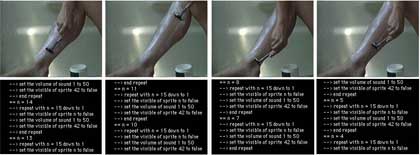
Natalie Bookchin's Databank of the Everyday, part of Database Imaginary
I've always loved the title of an exhibtion you co-curated with Steve Dietz, "The Art Formerly Known As New Media." That was a provocative title (I think). Which kind of discussion were you hoping to raise with such title & exhibition? Did a debate take place as you expected?
The curatorial remit for that exhibition was to look back across ten years of activity at the Banff New Media Institute in Canada, and so expectations were that we might curate some kind of 'best of' retrospective. Steve and I weren't as interested in that mode of exhibition making as we were in choosing works which might redefine for us what 'new media art' is, or what art is in the age after new media, if indeed we are in such an age. We looked at the work of hundreds of artists who had ever been to a new media event at Banff and asked many of them what they were doing now. We considered some of the big themes which had recurred in the discussions at Banff â" artificial intelligence, the body and biological matter, data visualisation, social networks, identity, memory, interactivity â" and thought about art works in relation to those.
The title caught peopleâs attention, though I'm not sure the show generated much debate (except perhaps over the way we installed the work of irational.org). It coincided with Re:fresh, the (so-called) first conference on the histories of media art and science, and I think the historians who attended might have liked to have seen a âbest ofâ retrospective after all, which would have been nice, but to us it didn't feel like the right mode to work in. Steve and I, with Anthony Kiendl, had before that curated the exhibition Database Imaginary, and so we were still asking questions like 'what is this thing called newness?' or âwhat is the behaviour of these works in relation to me?â or âwhat does this work of art tell me about the 'postmodern condition' or the informational-technological world I live in?â We hope people who saw that show (and you can still buy the t-shirt if you want!) left asking similar questions.
Together with Sabine Himmelsbach, you curated the exhibition "My Own Private Reality" at the Edith Russ Haus for Media Art in Oldenburg (Gerurg (Germany.) The works selected reflect the phenomenon of social communities on the Internet and its democratisation. What is your view on these issues? Critical? Openly enthusiastic?

I have what could be called an irrational aversion to the myspace.com 'phenomenon' because (of Murdoch but also because) I have what could be called a nostalgic snobbish adherence to earlier, better made, smaller, smarter versions of just about everything (depending who you ask I'm either old before my time, criticising that 'they don't make them like they used to' or I exhibit the all-consuming enthusiasm and desire of the early adopter). I think that some so-called web 2.0 technologies are the corporate world's way of creating dependent consumers and thereby discouraging alternative peer-to-peer computing from flourishing. Which is why I love Cory Arcangel's work BlueTube which just serves to remind viewers of the infrastructure which they so mindlessly meld in to. But I equally believe that these softwares (and especially the open source ones, which allow you to learn a little, and share, and to move beyond the generic template) make possible meaningful activity, through the social communities they encourage, which deserves a look in. It is interesting to see how having an alter-ego online, being a part of a community on the web, has come full circle â" from in the early 90s putting yourself online, to in the late 90s and early 00s being someone else online, or someone you canât be in your offline life, and now in the late 00s to a mix of those modes. Being part of an online social network is now an enhancement of your offline life. People are still learning the nuances and social manners and etiquette of this new hybrid existence.
I think curating is about challenging yourself and your beliefs, assumptions, and contradictions, so thatâs a reason I took the approach I did. I also wanted to curate this show because I knew of a lot of great art projects which are about the using the web to talk about the social impetus in all of us and I wanted the chance to think about that work all together in a space â" works which embody both of my views on the technology itself. Working with Sabine and her team at the Edith Russ Haus was fantastic; it's so vital to have spaces like that in the world where there aren't the pressures of a museum collection to maintain or enormous spaces to fill and instead there are artists in residence making new work for consideration (in our case Hans Bernard/Ubermorgen and Annina Rust).
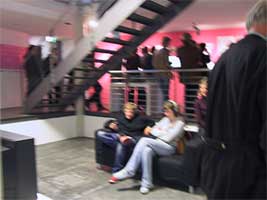
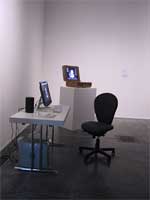
My Own Private Reality (more images)
How does one get to be like you, an internationally-esteemed curator of new media art?
Well, gee, hmmm. Having a degree from a curatorial programme (in my case Bard College) and working in esteemed institutions (The Walker Art Center; The National Gallery of Canada) helps gets the ball rolling. Then having a full-time research post at a University that is supportive of your freelance curatorial work (Thank you University of Sunderland) is invaluable. Otherwise, Iâd suggest that you find good people to collaborate with and learn from them (Thank you Steve Dietz). Try and be in the right places at the right times (Thank you Sara Diamond and Susan Kennard and the Banff New Media Institute). Donât be a hermit, except when you have to; in other words, network, but moreover, do good work, even if it means doing less (such a hard lesson to learn) (Thank you Beryl Graham). My favourite tea-leaf fortune says: Let your manners speak, your deeds prove, and your delivery impress.
Any upcoming CRUMB or personal project that you could share with us?
When I'm not under the blanket of the book CRUMB has been writing, one thing I struggle to do is give back to my city, to think globally but act locally. So while a lot of the curatorial projects I've done of late have been focused internationally, I hope to do something lasting for where I call home before I move elsewhere. So I'm trying to keep some time aside to work more with the awesome collectively-built and volunteer-run Star and Shadow Cinema in Newcastle (which is a cinema and so much more!) and (fingers crossed) I will be curating and commissioning work for the next AV Festival which takes place across the North East of England, on the theme of Broadcast.
Thanks Sarah!
More speculative products from The Science of Spying (see report Part 1 and >and Part 2). Like the precedents, the objects were designed to embody future scenarios of spying but also to stimulate a debate around the theme and contemporary issues of surveillance and control.
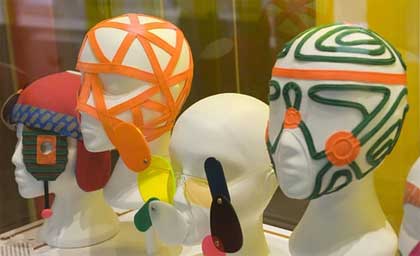
Image: The Science of...
One of my favourite idea was from El Ultimo Grito (i've got a soft spot for projects that comment on technology whitout using technology.) They designed simple face modification masks and stickers that modify the contours, features and temperature patterns picked up by facial recognition systems. The masks turn a recognisable face into one that CCTV monitors can no longer classify. Could grotesque faces become a fashion statement for people who want to avoid automatic CCTV classifications?
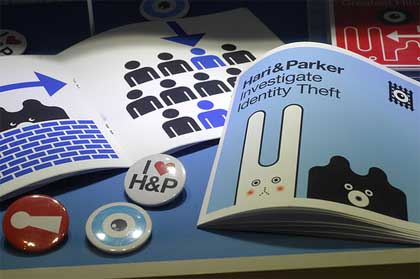
Image The Science of...
Hari & Parker do Junior Big Brother. Hari and Parker are cute little toys that love to hang around.
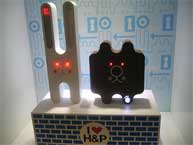 They watch and listen â" and they look great in a child's bedroom. The cute characters are in fact the speculative instruments of a government campaign to promote and encourage children to commit subtle acts of domestic surveillance.
They watch and listen â" and they look great in a child's bedroom. The cute characters are in fact the speculative instruments of a government campaign to promote and encourage children to commit subtle acts of domestic surveillance.
Hari has a microphone ear and Parker a video-camera nose and fingerprint-scanner paw.
The Hari&Parker brand is instantly recognisable. Their reassuring faces can be found on toys, sweets and freebies.
Design by Onkar Singh Kular, Wilfrid Wood and Anthony Burrill.
Troika's projects were inspired by the fact that, from Flickr to the Big Brother program, spying seems to become more and more integrated in our popular culture. Actually, the rise in self-awareness in an increasingly self-centered society motivated the London-based design studio to explore the possibility that the main thing worth spying on in the future, will be yourself.
Spying on yourself already exists in its infancy in the virtual world. The so-called âMywareâ, a logical evolution of Spyware, programs are installed voluntarily on your computer to get statistics of your on-line behavior. Advanced versions analyse your iTunes library to establish your taste profile and suggest a selection of music you might like.
In a similar way, Troika's Spy-on-yourself-devices monitor your physical behavior, and the non-verbal or subconscious signs you give away everyday, to offer you in return statistic of what you might like or dislike and suggestions on how to lead or improve your life.

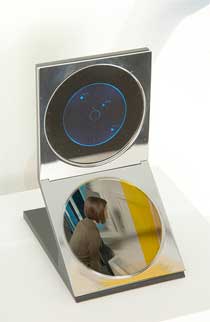
How Do I Look? in use (image Troika)
How Do I Look? is concealed in a make-up box. It automatically connects you to the closest CCTV camera and enables you to check how you look on their recordings. Could be a must-have for these people who use their cameraphone to check their hair.
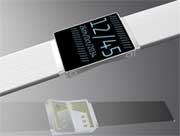 The Lie Trainer can assess if you are pulling a good lie or not.
The Lie Trainer can assess if you are pulling a good lie or not.
Concealed in a wrist-watch, the device monitors the userâs pulse-rate, skin conductivity, and in-blood levels of adrenaline. If you lie, the device will let you know by gently piercing you with the needles located on the reverse of the watch. The device will thus gradually teach you to have the confidence and calm to pull great lies anytime (that one made me think of Crispin Jones' watches.)
Factor 40 DNA protection spray stops you shedding your unique DNA by keeping your cells in place while adding a fine dusting of other peopleâs DNA. If someone snatched your DNA, they wouldnât find it so easy to identify you, or to pretend to be you.
Design by Troika; idea by Suw Charman.
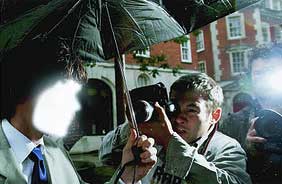
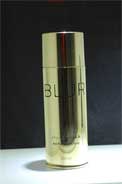
Blur anti-photography spray could keep the faces of celebrities out of the papers. It's the same principle as that Hewlett-Packard project of an electronic badge that jams electronic cameras, preventing photographers from taking unwanted pictures. Blurâs highly reflective nanoparticles reflect the flashbulbs of peeping and stalking photographers.
They blind camera sensors and whiten part of the image.
Design by Troika; idea by Kok-Chian Leong.
My images from the exhibition and Fiona Romeo's.
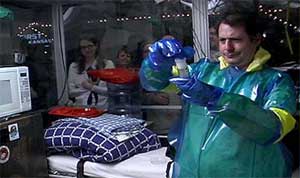 Rumor has it that before the Wright brothers, people got along fine without airplanes. Too bad they (the happy trippers, not the plane geniuses) are not here anymore to tell me their secret. Tomorrow morning i'll be flying to Edinburg, the city i've been dreaming to visit ever since i discovered Inspector Rebus and the existence of deep-fried mars bars. Michelle Kasprzak from Media Scotland has invited me to have a chat with Adam Zaretsky about âFuture Bodyâ at the Poker Club. The full blurb: Already some of us utilise advanced bio-augmentations in the form of pacemakers, cosmetic implants, and high-tech prostheses, but soon advances in genomics and tissue-culture engineering will allow us to modify ourselves and our children in a much more accessible and rapid fashion. Should we be panicked, or embrace the race for designed flesh?
Rumor has it that before the Wright brothers, people got along fine without airplanes. Too bad they (the happy trippers, not the plane geniuses) are not here anymore to tell me their secret. Tomorrow morning i'll be flying to Edinburg, the city i've been dreaming to visit ever since i discovered Inspector Rebus and the existence of deep-fried mars bars. Michelle Kasprzak from Media Scotland has invited me to have a chat with Adam Zaretsky about âFuture Bodyâ at the Poker Club. The full blurb: Already some of us utilise advanced bio-augmentations in the form of pacemakers, cosmetic implants, and high-tech prostheses, but soon advances in genomics and tissue-culture engineering will allow us to modify ourselves and our children in a much more accessible and rapid fashion. Should we be panicked, or embrace the race for designed flesh?
After that i'll be in London for the PSFK conference at Imagination Gallery. The morning will be about new trends and ideas in areas like digital media and eco-consciousness; and the afternoon will present a few ideas about the way to apply the insights gained from looking at trends and ideas onto new marketing, branding and design. Thanks Piers for the invitation.
Then down to sunny Sevilla for more modified bodies, genetics and manipulations at BIOS4. Arte biotecnológico y ambiental. The exhibition, curated by António Cerveira Pinto, opened last month at the Centro Andaluz de Arte Contemporaneo.
On Wednesday the 6th at 19:00, i'll be giving a talk at the MediaLab Madrid and spying on their workshop about Magic and Technology. A gig plotted by Edgar and Marcos.
After that i'll be in Paris then in Italy but at this point i've lost count of the dates and events i have to attend.
Meanwhile Sascha will be in Copenhagen presenting Buttons to an adoring Reboot audience.
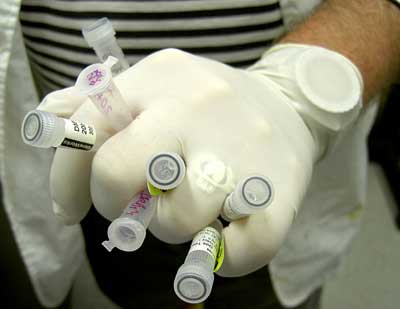 The winners of ars electronica are online. There is this new Hybrid Art i was particularly curious about. I feel that its boundaries should be made a bit clearer but I can't think of many art groups who deserved a Golden Nica more than Symbiotica.
The winners of ars electronica are online. There is this new Hybrid Art i was particularly curious about. I feel that its boundaries should be made a bit clearer but I can't think of many art groups who deserved a Golden Nica more than Symbiotica.
An award of distinction in that category was given to Wim Delvoye for the ultra-famous Cloaca, an installation that gulps food and mechanically processes and produces what is â"even under scientific examinationâ"impossible to differentiate from human excrement (not my favourite work in the lot but it is oh so photogenic.)
The other distinction award went to Biological Habitat: Breeding Spaces Technology, Made in Space, by Zbigniew Oksiuta, which explores possible ways to grow new forms of life in outer space. The project is based on the insight that environment and physical laws determine the respective forms of life to the extent that their âexperienceâ over the course of evolution is implemented in the building blocks of life, the strands of DNA. In the embryonic state, however, life emancipates itself from these guidelines and prescriptions. This is what the biological habitat uses; it provides a biotope that is not determined by gravitation and physical laws on Earth but rather byb1 r by conditions in outer space. Therefore, biological forms of life also develop differently here and â"similar to life on Earthâ" reproduce themselves over the course of an evolutionary process.
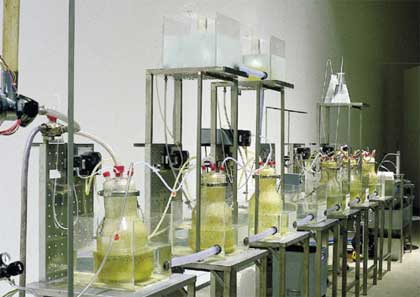
Cloaca
Honorary mentions went to Andrew Gracie (yay! congrarts!) and Brian Lee Yung Rowe of Hostprods for Autoinducer_Ph-1 (cross cultural chemistry); Blast Theory for Day of the Figurines; Masaki Fujihata's Unreflective Mirror; Evelina Domnitch and Dmitry Gelfand for Camera Lucida; Beatriz da Costa with Cina Hazegh and Kevin Ponto for Pigeon Blog.
and works i just discovered: Latent Figure Protocol, by Paul Vanouse; Nothing Happens by Nurit Bar-Shai; @c + Lia by Miguel Carvalhais, Pedro Tudela and Lia; Exploding Camera by Julien Maire; public conVENience, by Tabaimo; Five Pieces of Evidence by Raqs Media Collective.
Image on top corner: GeneMusiK, a project developed under the aegis of Symbiotica.

TV-Helmet (Portable living room), 1967
Prototypes, a series of sculptures made in the '60s by Walter Pichler, explore the overlap of architecture/design/sculpture. The materials (polyester, Plexiglas, PVC, aluminum, inflatable elements) used by the Austrian artist were new at the time.
Pieces such as TV Helmet (image above) and the Small Room (Prototype 4) thematize new media such as TV and telecommunications.
Related: Surroundings Defend System.
Via the online and increasingly good PDF magazine Mouse.
Blogged by Hack41
. . . . . . . . . . . . . . . . . . . . . . . . . . . . . . . .
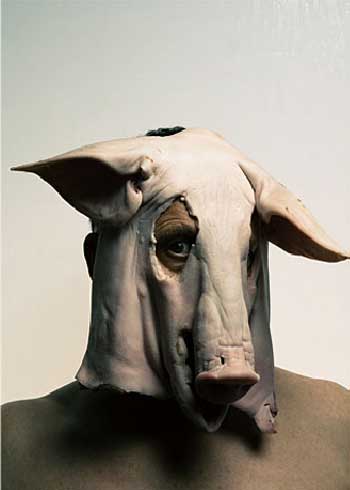

0 Comments:
Post a Comment
<< Home